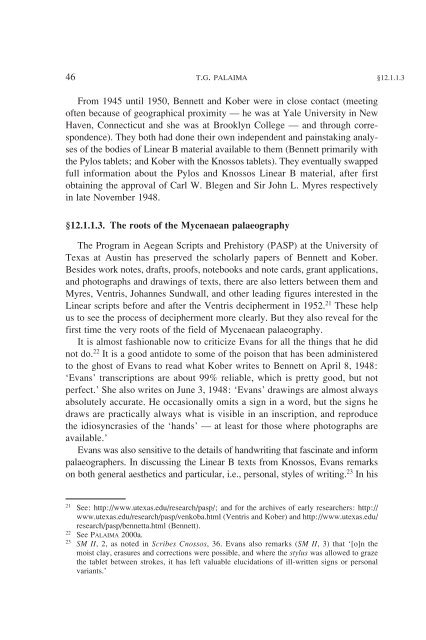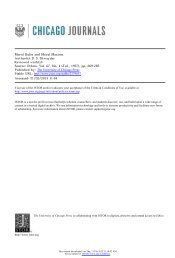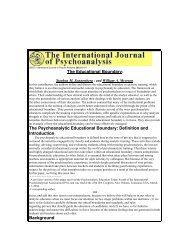A Companion to Linear B - The University of Texas at Austin
A Companion to Linear B - The University of Texas at Austin
A Companion to Linear B - The University of Texas at Austin
You also want an ePaper? Increase the reach of your titles
YUMPU automatically turns print PDFs into web optimized ePapers that Google loves.
46 T.G. PALAIMA §12.1.1.3<br />
From 1945 until 1950, Bennett and Kober were in close contact (meeting<br />
<strong>of</strong>ten because <strong>of</strong> geographical proximity — he was <strong>at</strong> Yale <strong>University</strong> in New<br />
Haven, Connecticut and she was <strong>at</strong> Brooklyn College — and through correspondence).<br />
<strong>The</strong>y both had done their own independent and painstaking analyses<br />
<strong>of</strong> the bodies <strong>of</strong> <strong>Linear</strong> B m<strong>at</strong>erial available <strong>to</strong> them (Bennett primarily with<br />
the Pylos tablets; and Kober with the Knossos tablets). <strong>The</strong>y eventually swapped<br />
full inform<strong>at</strong>ion about the Pylos and Knossos <strong>Linear</strong> B m<strong>at</strong>erial, after first<br />
obtaining the approval <strong>of</strong> Carl W. Blegen and Sir John L. Myres respectively<br />
in l<strong>at</strong>e November 1948.<br />
§12.1.1.3. <strong>The</strong> roots <strong>of</strong> the Mycenaean palaeography<br />
<strong>The</strong> Program in Aegean Scripts and Prehis<strong>to</strong>ry (PASP) <strong>at</strong> the <strong>University</strong> <strong>of</strong><br />
<strong>Texas</strong> <strong>at</strong> <strong>Austin</strong> has preserved the scholarly papers <strong>of</strong> Bennett and Kober.<br />
Besides work notes, drafts, pro<strong>of</strong>s, notebooks and note cards, grant applic<strong>at</strong>ions,<br />
and pho<strong>to</strong>graphs and drawings <strong>of</strong> texts, there are also letters between them and<br />
Myres, Ventris, Johannes Sundwall, and other leading figures interested in the<br />
<strong>Linear</strong> scripts before and after the Ventris decipherment in 1952. 21 <strong>The</strong>se help<br />
us <strong>to</strong> see the process <strong>of</strong> decipherment more clearly. But they also reveal for the<br />
first time the very roots <strong>of</strong> the field <strong>of</strong> Mycenaean palaeography.<br />
It is almost fashionable now <strong>to</strong> criticize Evans for all the things th<strong>at</strong> he did<br />
not do. 22 It is a good antidote <strong>to</strong> some <strong>of</strong> the poison th<strong>at</strong> has been administered<br />
<strong>to</strong> the ghost <strong>of</strong> Evans <strong>to</strong> read wh<strong>at</strong> Kober writes <strong>to</strong> Bennett on April 8, 1948:<br />
‘Evans’ transcriptions are about 99% reliable, which is pretty good, but not<br />
perfect.’ She also writes on June 3, 1948: ‘Evans’ drawings are almost always<br />
absolutely accur<strong>at</strong>e. He occasionally omits a sign in a word, but the signs he<br />
draws are practically always wh<strong>at</strong> is visible in an inscription, and reproduce<br />
the idiosyncrasies <strong>of</strong> the ‘hands’ — <strong>at</strong> least for those where pho<strong>to</strong>graphs are<br />
available.’<br />
Evans was also sensitive <strong>to</strong> the details <strong>of</strong> handwriting th<strong>at</strong> fascin<strong>at</strong>e and inform<br />
palaeographers. In discussing the <strong>Linear</strong> B texts from Knossos, Evans remarks<br />
on both general aesthetics and particular, i.e., personal, styles <strong>of</strong> writing. 23 In his<br />
21 See: http://www.utexas.edu/research/pasp/; and for the archives <strong>of</strong> early researchers: http://<br />
www.utexas.edu/research/pasp/venkoba.html (Ventris and Kober) and http://www.utexas.edu/<br />
research/pasp/bennetta.html (Bennett).<br />
22 See PALAIMA 2000a.<br />
23 SM II, 2, as noted in Scribes Cnossos, 36. Evans also remarks (SM II, 3) th<strong>at</strong> ‘[o]n the<br />
moist clay, erasures and corrections were possible, and where the stylus was allowed <strong>to</strong> graze<br />
the tablet between strokes, it has left valuable elucid<strong>at</strong>ions <strong>of</strong> ill-written signs or personal<br />
variants.’

















